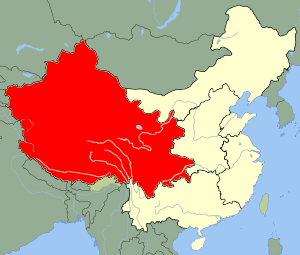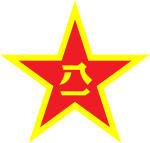
Back Západní válčiště Čínské lidové osvobozenecké armády Czech Komando Palagan Barat ID 中国人民解放軍西部戦区 Japanese 서부전구 Korean Западный военный округ (КНР) Russian Chiến khu Tây Bộ Quân Giải phóng Nhân dân Trung Quốc Vietnamese 中国人民解放军西部战区 Chinese Tiong-kok Jîn-bîn Kái-hòng-kun Se-pō͘ Chiàn-khu ZH-MIN-NAN
You can help expand this article with text translated from the corresponding article in Chinese. (January 2021) Click [show] for important translation instructions.
|
This article includes a list of general references, but it lacks sufficient corresponding inline citations. (January 2017) |
| Western Theater Command | |
|---|---|
| 西部战区 | |
 | |
| Founded | 1 February 2016 |
| Country | |
| Allegiance | |
| Type | Theater Command |
| Role | Command and control |
| Part of | |
| Headquarters | Chengdu, Sichuan |
| Website | Official website (in English) |
| Commanders | |
| Commander | General Wang Haijiang |
| Political Commisar | General Li Fengbiao |
| Chief of Staff | General Zhang Jian |
| Insignia | |
| Sleeve insignia |  |
| People's Liberation Army |
|---|
 |
| Executive departments |
| Staff |
| Services |
| Arms |
| Domestic troops |
| Special operations forces |
| Military districts |
| History of the Chinese military |
| Military ranks of China |
The Western Theater Command (Chinese: 西部战区; pinyin: Xībù zhànqū) is one of the five theater commands of the People's Liberation Army, founded on 1 February 2016.
Its jurisdiction includes Sichuan, Tibet, Gansu, Ningxia, Qinghai, Xinjiang, Shaanxi, Yunnan, Chongqing.[1] Guizhou is also sometimes listed as part of the command.[1] Its current commander since August 2021 is General Wang Haijiang.[2] Its current political commissar is General Li Fengbiao.
In May 2016, the PRC raised the rank and status of its western Tibet Military Command to widen its scope for missions and combat preparedness, in a move analysts in Beijing said was aimed in part at fortifying the border with India.[3] The Xinjiang Military Command may also be elevated in the future, the report said. Both commands are under the newly created Western Theater Command, the largest of five newly reorganised military regions of the PLA. The Chinese Communist Party-run tabloid Global Times reported the change would allow the command “to shoulder more combat assignments”.[3]
- ^ a b Sumit Ganguly; Andrew Scobell; Joseph Chinyong Liow, eds. (2017). The Routledge Handbook of Asian Security Studies. Routledge. ISBN 978-1315455631. Archived from the original on July 30, 2022. Retrieved July 30, 2022.
- ^ "Chinese President Xi appoints new General for PLA's Western Theatre Command amidst Ladakh standoff". economictimes. Archived from the original on January 31, 2022. Retrieved December 20, 2020.
- ^ a b "Eye on India, China raises Tibet military command rank | Central Tibetan Administration". tibet.net. Archived from the original on November 7, 2016. Retrieved October 1, 2016.